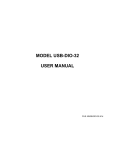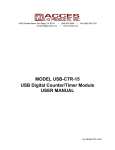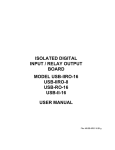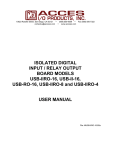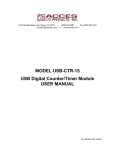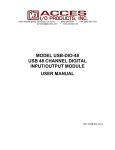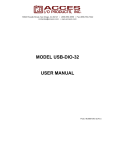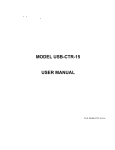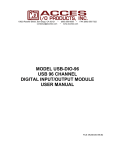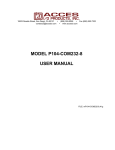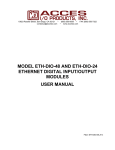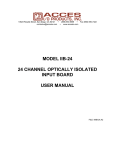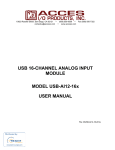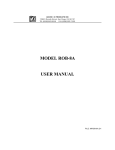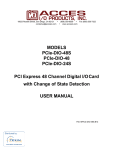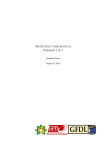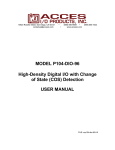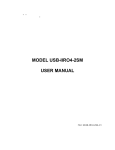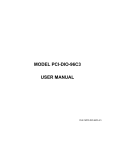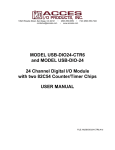Download USB-DIO-32 User Manual - ACCES I/O Products, Inc.
Transcript
10623 Roselle Street, San Diego, CA 92121 • (858) 550-9559 • FAX (858) 550-7322 [email protected] • www.accesio.com MODEL USB-DIO-32 32 Channel Digital I/O Module with Optional 82C54 Counter/Timers USER MANUAL FILE: MUSB-DIO-32.A1h Notice The information in this document is provided for reference only. ACCES does not assume any liability arising out of the application or use of the information or products described herein. This document may contain or reference information and products protected by copyrights or patents and does not convey any license under the patent rights of ACCES, nor the rights of others. IBM PC, PC/XT, and PC/AT are registered trademarks of the International Business Machines Corporation. Printed in USA. Copyright 2004, 2005 by ACCES I/O Products Inc, 10623 Roselle Street, San Diego, CA 92121. All rights reserved. WARNING!! ALWAYS CONNECT AND DISCONNECT YOUR FIELD CABLING WITH THE COMPUTER POWER OFF. ALWAYS TURN COMPUTER POWER OFF BEFORE INSTALLING A CARD. CONNECTING AND DISCONNECTING CABLES, OR INSTALLING CARDS INTO A SYSTEM WITH THE COMPUTER OR FIELD POWER ON MAY CAUSE DAMAGE TO THE I/O CARD AND WILL VOID ALL WARRANTIES, IMPLIED OR EXPRESSED. 2 Manual USB-DIO-32 Warranty Prior to shipment, ACCES equipment is thoroughly inspected and tested to applicable specifications. However, should equipment failure occur, ACCES assures its customers that prompt service and support will be available. All equipment originally manufactured by ACCES which is found to be defective will be repaired or replaced subject to the following considerations. Terms and Conditions If a unit is suspected of failure, contact ACCES' Customer Service department. Be prepared to give the unit model number, serial number, and a description of the failure symptom(s). We may suggest some simple tests to confirm the failure. We will assign a Return Material Authorization (RMA) number which must appear on the outer label of the return package. All units/components should be properly packed for handling and returned with freight prepaid to the ACCES designated Service Center, and will be returned to the customer's/user's site freight prepaid and invoiced. Coverage First Three Years: Returned unit/part will be repaired and/or replaced at ACCES option with no charge for labor or parts not excluded by warranty. Warranty commences with equipment shipment. Following Years: Throughout your equipment's lifetime, ACCES stands ready to provide on-site or in-plant service at reasonable rates similar to those of other manufacturers in the industry. Equipment Not Manufactured by ACCES Equipment provided but not manufactured by ACCES is warranted and will be repaired according to the terms and conditions of the respective equipment manufacturer's warranty. General Under this Warranty, liability of ACCES is limited to replacing, repairing or issuing credit (at ACCES discretion) for any products which are proved to be defective during the warranty period. In no case is ACCES liable for consequential or special damage arriving from use or misuse of our product. The customer is responsible for all charges caused by modifications or additions to ACCES equipment not approved in writing by ACCES or, if in ACCES opinion the equipment has been subjected to abnormal use. "Abnormal use" for purposes of this warranty is defined as any use to which the equipment is exposed other than that use specified or intended as evidenced by purchase or sales representation. Other than the above, no other warranty, expressed or implied, shall apply to any and all such equipment furnished or sold by ACCES. 3 Manual USB-DIO-32 Table of Contents Chapter 1: Introduction ...................................................................................................... 5 Features ........................................................................................................................... 5 Applications ..................................................................................................................... 5 Functional Description.................................................................................................... 6 Counter/Timers ................................................................................................................ 6 Figure 1-1: Block Diagram ............................................................................................ 7 Ordering Guide ................................................................................................................ 8 Model Options ................................................................................................................. 8 Special Order ................................................................................................................... 8 Customization and Special Functions ........................................................................... 8 Included with your board ................................................................................................ 8 Figure 1-2: Enclosure Label ........................................................................................ 10 Chapter 2: Installation ...................................................................................................... 11 Software CD Installation ............................................................................................... 11 WINNT/2000/XP/2003 ..................................................................................................... 11 Hardware Installation .................................................................................................... 11 Chapter 3: Hardware Details ............................................................................................ 12 Option Selections .......................................................................................................... 12 Figure 3-1: Option Selection Map ............................................................................... 12 USB Connector .............................................................................................................. 13 LED ................................................................................................................................. 13 DC Power Jack (Optional)............................................................................................. 13 50 Pin Box Header ......................................................................................................... 13 Pull-Up / Pull-Down Configuration Jumpers ............................................................... 13 Chapter 4: USB Address Information .............................................................................. 14 Chapter 5: Programming .................................................................................................. 15 Chapter 6: Connector Pin Assignments ......................................................................... 16 Table 6-1: 50-Pin Connector Pin Assignments............................................................ 16 Table 6-2: S01 Version Connector Pin Assignments .................................................. 17 Chapter 7: Specifications ................................................................................................. 18 Appendix A: 8254 Counter/Timer .................................................................................... 20 Customer Comments ........................................................................................................ 22 4 Manual USB-DIO-32 Chapter 1: Introduction Features • 32 lines of digital I/O • High-speed USB 2.0 device, USB 1.1 backwards compatible • Four 8-bit ports independently selectable for inputs or outputs • All 32 I/O lines buffered with 32 mA source, 64mA sink current capabilities • Three 82C54 counters capable of event counting, frequency measurement, pulse width measurement, or frequency generation • Terminal block adapter card for easy wiring • I/O Buffers can be enabled or tri-stated under program control • I/O jumper configured for pulled up to 5V (via 10KΩ) for dry-contact monitoring or pulled down to ground • Jumper selectable power provided via USB cable or external power supply for higher source current capabilities • Resettable fused +5VDC output • Standard 50pin IDC type connector with key • PC/104 size (3.550 by 3.775 in.) • Rugged industrial enclosure • Compatible with Industry-Standard I/O Racks such as Gordos, OPTO22, Potter & Brumfield, etc. with optional cable Applications • Automatic Test Systems • Laboratory Automation • Robotics • Machine Control • Security Systems, Energy Management • Relay Monitoring and Control • Parallel Data Transfer to PC • Sensing Switch Closures or TTL, DTL, CMOS Logic • Driving Indicator Lights or Recorders 5 Manual USB-DIO-32 Functional Description This USB board is an ideal solution for adding portable, easy-to-install digital I/O and counter capabilities to any computer with a USB port. The board is a USB 2.0 high speed device, offering the fastest speed available with the USB bus. It is fully compatible with both USB 1.1 and USB 2.0 ports. The card is plug-and-play allowing quick connect/disconnect whenever you need additional I/O on your USB port. The board features 32 bits of TTL-compatible digital I/O with high-current capabilities and three optional 82C54 counters. Each digital port can be programmed to accept inputs or to drive outputs on four 8-bit ports, designated as port A, B, C, and D. Power is supplied to the card via the USB cable or for higher current capabilities, external power may be used. The I/O wiring connections are via an industry standard 50-pin connector or via an optional terminal block adapter card. For external circuits, fused +5VDC power is available at the connector. The resettable fuse is rated at 0.5A. All I/O lines are buffered by a type 74ABT245 tristate buffer transceiver capable of sourcing 32 mA or sinking 64 mA. The buffers are configured under program control for input or output. I/O lines are jumper selectable via 10KΩ pull-ups (to +5 VDC) or pull-downs (to ground) on the card. This jumper can be removed to provide a floating state for the I/O when it is neither pulled up nor down. For compatibility with industry standard solid state module mounting racks, see the ordering guide for the appropriate designator to use. External power is required for the logic side of the module mounting rack as the load is typically greater than what can be provided over a USB port. Unlike most USB digital I/O products which primarily use a human interface device (HID) driver, we provide an easy to use, Windows-based, custom function driver optimized for maximum data throughput. This approach exposes the full functionality of the hardware along with maximizing the advantage of using the high-speed USB 2.0 bus. The board is designed to be used in rugged industrial environments but is small enough to fit nicely onto any desk or testing station. The board is PC/104 size (3.550 by 3.775 inches) and ships inside a steel powder-coated enclosure with an anti-skid bottom. Counter/Timers Optionally available on the board are one-, two-, or three- 82C54 counters that each include three 16-bit counter/timers factory configured in an optimal module for use as event counters, frequency output, pulse width, and frequency measurement. 6 Manual USB-DIO-32 Figure 1-1: Block Diagram 7 Manual USB-DIO-32 Ordering Guide USB-DIO-32 USB 32-channel digital input/output module Model Options -C1 -C2 -C3 -OEM -E -DIN -P -RoHS Add one (1) 82C54 counter/timer Add two (2) 82C54 counter/timers Add three (3) 82C54 counter/timers Board only version with no enclosure Economy version includes no screw terminal DIN rail mounting bracket for integrating into existing DIN rail systems On-board DC power circuitry and external power AC/DC adapter This product is available in a RoHS compliant version. Please call for specific pricing then be sure to add this suffix to the model number on any hard-copy or verbal purchase orders. Special Order -S01 -S0x Compatible with industry standard 24-line solid state module racks Contact factory with your special requirement. Examples of special orders would be conformal coating, latching I/O headers. Customization and Special Functions Due to the nature of our USB modules, many special functions can be implemented with a combination of custom firmware and an associated DLL entry point, for little to no NRE. Functions such as quadrature input, pulse-width modulated outputs, even input debouncing. Call us to discuss your requirement! Included with your board The following components are included with your shipment, depending on options ordered. Please take the time now to ensure that no items are damaged or missing. USB Module in labeled enclosure with an anti-skid bottom Universal screw terminal block 6' USB 2.0 cable Software Master CD USB I/O Quick-Start Guide 8 Manual USB-DIO-32 Optional Accessories CAB50F-6 Six-foot ribbon cable assembly with 50-pin female connectors CAB50-6 Six-foot ribbon cable assembly with a 50-pin female header connector and a 50-pin female edge connector STB-50 Screw terminal board, typically ships with standoffs but can also mount on SNAP-TRACK or DIN-SNAP DIN-SNAP-6 Six inch length of SNAP-TRACK with two clips, for mounting one STB-50 screw terminal board on a DIN rail DIN-SNAP One foot length of SNAP-TRACK with four clips, for mounting up to two STB-50 screw terminal boards on a DIN rail MP104-DIN DIN-rail mounting adapter plate for affixing any USB/104 module to a DIN-rail 9 Manual USB-DIO-32 Figure 1-2: Enclosure Label 10 Manual USB-DIO-32 Chapter 2: Installation Software CD Installation These paragraphs are intended to detail the software installation steps as well as describe what is being installed. The software provided with this board is contained on one CD and must be installed onto your hard disk prior to use. To do this, perform the following steps as appropriate for your software format and operating system. Substitute the appropriate drive letter for your CDROM or disk drive where you see in the examples below. WINNT/2000/XP/2003 a. b. c. Place the CD into your CD-ROM drive. The CD should automatically run the install program. If the install program does not click START | RUN and type , click OK or press . Follow the on-screen prompts to install the software for this board. Hardware Installation The board can be installed in any USB 2.0 or USB 1.1 port. Please refer to the USB I/O Quick Start Guide which can be found on the CD, for specific, quick steps to complete the hardware and software installation. 11 Manual USB-DIO-32 Chapter 3: Hardware Details Option Selections Refer to the setup programs on the CD provided with the board. Also, refer to the Block Diagram and the Option Selection Map when reading this section of the manual. Figure 3-1: Option Selection Map 12 Manual USB-DIO-32 USB Connector The USB connector is a Type B connector and mates with the cable provided. The USB port provides communication signals along with +5 VDC power. The board can be powered from the USB port or, if needed for higher current applications, an external power supply can be used. LED The LED on the front of the enclosure is used to indicate power and data transmissions. When the LED is in an illuminated steady green state, this signifies that the board is successfully connected to the computer and has been detected and configured by the operating system. When the LED flashes continuously, this signifies that there is data being transmitted over the USB bus. DC Power Jack (Optional) This is an option for high current applications when more current is needed than what your computer can provide on the USB port (typically 500 mA). The DC jack has a 2.00mm post on board and is designed to be used with the 9 VDC AC/DC external power supply that ships with this option. The voltage regulator on board regulates the 9 VDC and provides 5 VDC to the onboard circuitry. When using external power, switch the jumper located near the USB connector to VEXT, otherwise when the jumper is in the VUSB position current is drawn from the USB port (please consult the option selection map for a visual reference). 50 Pin Box Header The 50 pin box header has standard .100" spacing between pins and is keyed to prevent improper connections. It can be used with standard IDC type ribbon cables or the screw terminal board that plugs directly into the box header. Pull-Up / Pull-Down Configuration Jumpers Each 8-bit port (A, B, C and D) can be jumper configured to be pulled up to +5V via 10KΩ (for dry-contact monitoring) or pulled down (for positive control logic applications). When no jumpers are installed, the lines are left floating, however due to the 10K resistor packs any un-used input will not have suppressed cross-talk. For pull-ups (most common), install these jumpers in the +5V position. For pull-downs, install these jumpers in the GND position. For neither, remove these jumpers. 13 Manual USB-DIO-32 Chapter 4: USB Address Information Use the provided driver to access the USB board. This driver will allow you to determine how many supported USB devices are currently installed, and each device’s type. This information is returned as a Vendor ID (VID), Product ID (PID) and Device Index. The board’s VID is “0x1605", and its PID is “0x8001". The Device Index is determined by how many of the device you have in your system, and provides a unique identifier allowing you to access a specific board at will. 14 Manual USB-DIO-32 Chapter 5: Programming The driver software provided with the board uses a 32-bit .dll front end compatible with any Windows programming language. Samples provided in Borland C++Builder, Borland Delphi, Microsoft Visual Basic, and Microsoft Visual C++ demonstrate the use of the driver. The following functions are provided by the driver in Windows. These functions will allow you to read or write individual bits, bytes, or the entire board worth of data. In addition, counter-timer functionality and board-level functions complete the driver package. For detailed information on each function refer to the .html Driver Manual located in the Win32 directory for this board. unsigned long GetDevices(void ) unsigned long QueryDeviceInfo(DeviceIndex, pPID, pName, pDIOBytes, pCounters) unsigned long DIO_Configure(DeviceIndex, bTristate, pOutMask, pData) unsigned long DIO_Write1(DeviceIndex, BitIndex, bData) unsigned long DIO_Write8(DeviceIndex, ByteIndex, Data) unsigned long DIO_WriteAll(DeviceIndex,pData) unsigned long DIO_Read8(DeviceIndex, ByteIndex,pBuffer) unsigned long DIO_ReadAll(DeviceIndex,Buffer) unsigned long CTR_8254Mode(DeviceIndex, BlockIndex, CounterIndex, Mode) unsigned long CTR_8254ModeLoad(DeviceIndex, BlockIndex, CounterIndex,Mode, LoadValue) unsigned long CTR_8254ReadModeLoad(DeviceIndex, BlockIndex, CounterIndex, Mode, LoadValue , pReadValue) unsigned long CTR_8254Read(DeviceIndex, BlockIndex, CounterIndex, pReadValue) unsigned long CTR_StartOutputFreq(DeviceIndex, CounterIndex, pHz) 15 Manual USB-DIO-32 Chapter 6: Connector Pin Assignments A 50-pin male header connector protrudes through a cutout in the enclosure for I/O connections. Connector pin assignments are listed below. An asterisk (*) denotes an optional signal. Table 6-1: 50-Pin Connector Pin Assignments PIN FUNCTION PIN FUNCTION 1 C7 2 *COUNTER A0 IN 3 C6 4 *GATE A1 5 C5 6 *OUT A2 7 C4 8 *COUNTER B0 IN 9 C3 10 *GATE B1 11 C2 12 *OUT B2 13 C1 14 *COUNTER C0 IN 15 C0 16 *GATE C1 17 B7 18 *OUT C2 19 B6 20 D7 21 B5 22 D6 23 B4 24 GROUND 25 B3 26 D5 27 B2 28 GROUND 29 B1 30 D4 31 B0 32 GROUND 33 A7 34 D3 35 A6 36 GROUND 37 A5 38 D2 39 A4 40 GROUND 41 A3 42 D1 43 A2 44 GROUND 45 A1 46 D0 47 A0 48 GROUND 49 Fused +5VDC 50 GROUND 16 Manual USB-DIO-32 Table 6-2: S01 Version Connector Pin Assignments PIN FUNCTION PIN FUNCTION 1 C7 2 N/C 3 C6 4 N/C 5 C5 6 N/C 7 C4 8 N/C 9 C3 10 N/C 11 C2 12 N/C 13 C1 14 N/C 15 C0 16 N/C 17 B7 18 N/C 19 B6 20 N/C 21 B5 22 N/C 23 B4 24 GROUND 25 B3 26 N/C 27 B2 28 GROUND 29 B1 30 N/C 31 B0 32 GROUND 33 A7 34 N/C 35 A6 36 GROUND 37 A5 38 N/C 39 A4 40 GROUND 41 A3 42 N/C 43 A2 44 GROUND 45 A1 46 N/C 47 A0 48 GROUND 49 N/C 50 GROUND 17 Manual USB-DIO-32 Chapter 7: Specifications Digital Inputs (TTL Compatible) • Logic High: 2.0 VDC min, 5.5 VDC max • Logic Low: 0.8 VDC max, -0.5 VDC min • Bias Resistors: 10K Ω Digital Outputs • Logic High: 2.0 VDC min., source 32 mA • Logic Low: 0.55 VDC max., sink 64 mA Counter/Timers • Type: 82C54-10 programmable interval counters • Output Drive: 2.0 VDC min., source 32 mA 0.55 VDC max., sink 64 mA • Maximum Input Frequency: 10MHz • Input Gate: TTL/CMOS compatible • Clock: On-board, 3 MHz crystal-controlled clock • Active Count Edge: Negative edge • Minimum Clock Pulse Width: 30 ns high, 40 ns low • Timer Range: 16 bits Bus Type • USB2.0 high-speed (480 Mb/s) Power • Basic unit: 80 mA typical (no load) • +5 VDC from the USB bus or external power supply depending on user configuration. The USB bus is specified to provide 500 mA to most desktop environments. This gives you 420 mA available (500mA -80mA = 420mA). If using more than a total of 500mA, use optional 9 VDC (on board voltage regulator outputs +5 VDC to card) external power supply and remove VUSB jumper and place jumper on VEXT. Then plug in external power before plugging into USB port . This option will give you a total of 1000mA available. • +5V resettable fuse at 0.5A located on connector. 18 Manual USB-DIO-32 Environmental • Operating Temperature Range: 0 °C. to 70 °C. • Storage Temperature Range: -40 °C. to +85 °C. • Humidity: 0 to 90% RH, non-condensing. • Board Dimension: 3.550 x 3.775 inches. • Box Dimension: 4.00 x 4.00" x 1.25 inches. 19 Manual USB-DIO-32 Appendix A: 8254 Counter/Timer These boards have the option of one, two, or three 82C54 counter(s) that each include three 16-bit counter/timers factory configured in an optimal module for use as event counters, frequency output, pulse width, and frequency measurement (See Block Diagram). Each counter can be programmed to any count as low as 1 or 2, and up to 65,536, depending on the mode chosen. For those interested in more detailed information, a full description can be found in the Intel (or equivalent manufacturer's) data sheet, provided in the /chipdocs directory on the Software Master CD. Refer to Chapter 5: Programming, and the .html Driver Manual document installed by the Software Master CD for information on using the installed software driver for this board. The following data is provided only for reference, as it is unlikely to be needed when using the provided driver. Please note the block diagram description of how the 9 pins associated with 8254 counters are configured into an optimum counter-timer module on this board. Operational Modes The 8254 modes of operation are described in the following paragraphs to familiarize you with the versatility and power of this device. For those interested in more detailed information, a full description of the 8254 programmable interval timer can be found in the Intel (or equivalent manufacturers') data sheets. The following conventions apply for use in describing operation of the 8254 : Clock: Trigger: Counter Loading: A positive pulse into the counter's clock input A rising edge input to the counter's gate input Programming a binary count into the counter Mode 0: Pulse on Terminal Count After the counter is loaded, the output is set low and will remain low until the counter decrements to zero. The output then goes high and remains high until a new count is loaded into the counter. A trigger enables the counter to start decrementing. Mode 1: Retriggerable One-Shot The output goes low on the clock pulse following a trigger to begin the one-shot pulse and goes high when the counter reaches zero. Additional triggers result in reloading the count and starting the cycle over. If a trigger occurs before the counter decrements to zero, a new count is loaded. This forms a retriggerable one-shot. In mode 1, a low output pulse is provided with a period equal to the counter count-down time. Mode 2: Rate Generator This mode provides a divide-by-N capability where N is the count loaded into the counter. When triggered, the counter output goes low for one clock period after N counts, reloads the initial count, and the cycle starts over. This mode is periodic, the same sequence is repeated indefinitely until the gate input is brought low. This mode also works well as an alternative to mode 0 for event counting. 20 Manual USB-DIO-32 Mode 3: Square Wave Generator This mode operates like mode 2. The output is high for half of the count and low for the other half. If the count is even, then the output is a symmetrical square wave. If the count is odd, then the output is high for (N+1)/2 counts and low for (N-1)/2 counts. Periodic triggering or frequency synthesis are two possible applications for this mode. Note that in this mode, to achieve the square wave, the counter decrements by two for the total loaded count, then reloads and decrements by two for the second part of the wave form. Mode 4: Software Triggered Strobe This mode sets the output high and, when the count is loaded, the counter begins to count down. When the counter reaches zero, the output will go low for one input period. The counter must be reloaded to repeat the cycle. A low gate input will inhibit the counter. Mode 5: Hardware Triggered Strobe In this mode, the counter will start counting after the rising edge of the trigger input and will go low for one clock period when the terminal count is reached. The counter is retriggerable. The output will not go low until the full count after the rising edge of the trigger. 21 Manual USB-DIO-32 Customer Comments If you experience any problems with this manual or just want to give us some feedback, please email us at: [email protected]. Please detail any errors you find and include your mailing address so that we can send you any manual updates. 10623 Roselle Street, San Diego CA 92121 Tel. (858)550-9559 FAX (858)550-7322 www.accesio.com 22 Manual USB-DIO-32






















